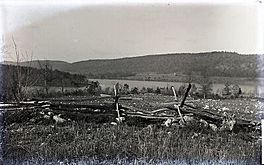Lake Owassa facts for kids
Quick facts for kids Lake Owassa |
|
|---|---|
| Long Pond | |

Lake Owassa in Frankford Township, New Jersey, as seen in 1896. Kittatinny Mountain is seen in the background.
|
|
| Location | Sussex County, New Jersey |
| Coordinates | 41°09′05″N 74°48′42″W / 41.1512971°N 74.8117095°W |
| Type | lake |
| Surface area | 275 acres (111 ha) |
Lake Owassa is a beautiful freshwater lake located in Frankford Township in Sussex County, New Jersey. It used to be known as Long Pond. This lake is an important part of the Paulins Kill river system.
Contents
About Lake Owassa
Lake Owassa covers an area of about 275 acres (111 ha). That's like 200 football fields! It sits at an elevation of about 866 feet (264 m) above sea level. This means it's quite high up compared to the ocean.
Where is Lake Owassa Located?
You can find Lake Owassa in the northern part of New Jersey. It's specifically in Sussex County, New Jersey, within Frankford Township. This area is known for its natural beauty and many lakes.
How Does Lake Owassa Get Its Water?
The lake gets its water from a few places. One main source is the runoff from Kittatinny Mountain. This mountain range runs along the western side of the lake. Another source is a place called Bear Swamp.
Where Does Lake Owassa's Water Go?
Water from Lake Owassa doesn't stay put! It flows into another nearby lake called Culver's Lake. Culver's Lake was once known as Round Pond. After that, the water continues its journey into the West Branch of the Paulins Kill. The Paulins Kill is a river that eventually flows into the Delaware River.
The Story Behind the Name
The name "Owassa" sounds like it might come from Native American languages. However, it's actually a unique story! The name was created by a local clergyman named George William Lloyd. He lived in Branchville, New Jersey.
Mr. Lloyd wrote a long poem for his wife, Sarah Prince Lloyd, after she passed away. In this poem, he invented a fictional Native American character named Owassa. The lake was then given this name, even though it wasn't a real Native American word from the local Lenape people. The Lenape spoke dialects like Unami and Munsee.


